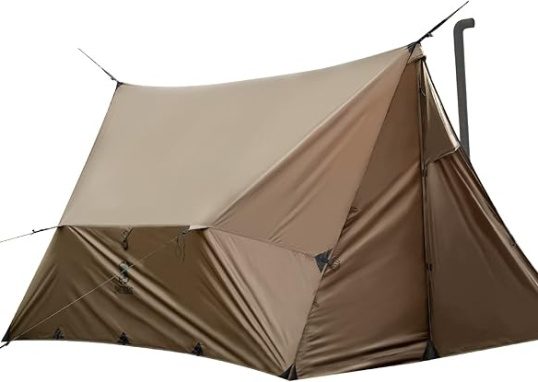Definitions

As with most things equipment is not cheap, so to ensure you spend those hard earned ££ then knowing more about what you are looking for will help. It is also very important that you know and understand what your equipment is capable of and what it can protect you from. This list of definitions should help you make better choices.
R-value.
The term R-value stands for thermal resistance and is a measure of the level of resistance to heat flow a given material or an assembly can offer as a result of suppressing conduction, convection, and radiation. In other words, this is the value given to a sleeping mat. The higher the R value the warmer you will be and a good value to aim for is 6 or above.
This value is commonly overlooked by newcomers, but it is probably the most important part of a sleeping system, and higher values mean you need less on top, the ground is the biggest source for heat loss and sucks heat out of you. Do not scrimp on this, there are various options such as blow-up mats, roll mats and so on all with pros and cons but my personal favourite is the closed cell roll mat. Suchy as the British Army have. Fairly cheap and very robust and you can feel the heat being redirected back into your body.

Authors note: Many sleeping mats these days come saying they are ASTM tested, ASTM is described later in this post. Anyone would be forgiven for saying that an R value of 8 means you are going to stay warmer than a mat with an R value of 5, but in reality, this is not true. The R value depends on how the mat is constructed and also relies on the air insulation be warmed up by the reflective heat of your body. ASTM tested simply means the reflective heat is calculated using instruments which are calibrated but you as a person are not calibrated, and people weigh different amounts and sleep in different positions. Too much air insulation between the R value material means it will take longer to warm up and when you move the air needs to be reheated which in turn makes you feel cold. Too little and air will not be present, and you will feel cold spots as your body pushes the air away. So, overall, the R value is dependant on thickness and also internal construction of the mat to ensuring the air gets evenly warmed up and stays warm. So, a mat well-constructed with an R value of 5 may give you better warmth than that of a mat not so well constructed but has an R value of 8 or more.
Hydrostatic Head
The term hydrostatic head is used to denote the amount of pressure of water that is required in order to penetrate a given fabric. Some products, such as tents and jackets are by their very nature intended to protect the user from the wind, rain, snow, sun and so on.
Typical values are:
- Up to 5,000mm: Light Rain
- 5,000mm – 10,000mm: Average to Heavy Rain
- 10,000mm & Above: Very Heavy Rain
MVTR
Breathability is the amount of water vapour that can be let out through a fabric. Testing the breathability of our clothing involves checking how well the fabric allows sweat to escape. They use a method called moisture vapor transmission rate (MVTR) testing. This measures how quickly moisture passes through the fabric over a specific time. Higher MVTR values mean the fabric is more breathable, making it more comfortable during outdoor activities. Conducting these tests ensures clothing efficiently manages sweat, keeping adventurers cool and dry during their journeys.
Breathability has a similar scale to waterproof rating, the higher the number, the more breathable the garment is going to be. Breathability is measured in g/m2/24hrs.
Seasonal
You will often find products marked as 3 or 4 season e.g. tents are categorized as either four-season or three-season tents & sleeping bags are the same. Four-season tents & sleeping bags are designed to be used in any weather conditions, while three-season tents & sleeping bags are meant to be used only in spring, summer and autumn. Four-season tents & sleeping bags offer better insulation and durability to withstand harsh winter weather.
Freestanding
Some styles of tents require stakes or guy lines for stability, but freestanding tents do not require any additional support. The tent poles of a freestanding tent often connect into a peg at the base of the tent allowing it to stand up without being staked into the ground.
ISO 23537
When shopping for a sleeping bag, the temperature rating can help you determine which sleeping bag is right for your climate and season. Sleeping bag temperature ratings are a universal standard controlled by the International Organization for Standardization and include the comfort temperature, maximum temperature, limit temperature and extreme temperature. Sleeping bag temperature ratings represent the temperature when an average person can sleep comfortably, may perspire slightly, may be nearly cold but still in equilibrium and may be at risk of hypothermia, respectively.
NOTE 1 No prediction model exists for the determination of the limiting temperatures based on the thermal resistance of the sleeping bag for children and babies. Moreover, such a model for testing cannot be developed because the necessary controlled sleep trials with children or babies in climatic chambers are, out of ethical reasons, not permitted.
NOTE 2 The limit temperature for extreme climate conditions is seen to be −20 °C.
ISO 23537 describes the method for the assessment of the performance in steady-state conditions of a sleeping bag with regard to the protection against cold.
NOTE 3 Sleeping bags without homogeneous fillings designed to provide local extra insulation in certain parts pose issues with the calibration and/or test procedure.
My personal favourite is the British Army military modular sleep system. This ingenious 5 season sleeping bag features three bags in one – a medium weight bag, a lightweight bag, and an inner liner – giving you a comfort rating of around -20°C and an extreme rating of -32°C when all combined together. Combine these and you can survive most temperatures but can be used separately with a 3-season lightweight bag and the medium weight 4-season artic bag. Extremely good value for the money. The lightweight bag also has a bug net built into the hood to keep the mosquitos at bay.

ASTM
ASTM American Society for Testing and Materials, this is another standard you may come across.
ISO certification is typically viewed as an indication of quality and credibility, while simultaneously, ISO certification can give organizations a competitive advantage and distinction in the international marketplace.
On the other hand, ASTM does not generally require formal certification. Instead, ASTM standards serve more as guidelines on product testing and quality assurance. Testing either in-house or outsourced can be done by an organization to ensure its products meet ASTM standards; however, there is no formal certification like that of ISO. This difference reflects ASTM’s focus on technical specifications rather than overarching management systems. ISO and ASTM standards play crucial roles in maintaining product quality and compliance.
In a nutshell if a product has been ASTM tested it indicates it has been formally tested and signifies that other specifications such as R values are correct
Double-wall
Most dome tents will either have a double-wall or single-wall construction. Double-walled tents have an inner wall, called a “canopy” that is made of a breathable and lightweight material. The canopy of a double-walled tent is typically not waterproof. The outer layer is called a “fly” which is waterproof and protects the canopy from wind and rain. A single-walled tent has only one layer of fabric that is waterproof and provides insulation. Single-walled tents are made of lightweight material, but they may not be very breathable or allow much airflow inside the tent.
Tarp
Also known as a basha in military terms. A tarp is usually a square piece of fabric with lashing loops on it, and they are very versatile and can be made into countless configurations. They can be placed on a ridge line between two trees or used with poles, such as trekking poles to hold it up. Most are made of a good waterproof material and come in various sizes. I personally have the DD Hammocks – DD Tarp 3.5 x 3.5 MC – Waterproof Camouflage Camping Tarp for Lightweight Hammock Camping and Bushcraft Shelters. Amazon link here

Footprint
A tent footprint is a flat, waterproof fabric that goes under a tent to protect it from moisture, abrasion, and general wear and tear. Alternatively called a ground sheet, also ones which come up the side of a tent a little are known as bathtubs.
Vestibule
Storing gear: Keep muddy or damp clothing, shoes, and other gear out of your tent to reduce moisture and condensation.
Sleeping pets: Provide a place for pets to sleep that’s close to you but doesn’t take up room in your tent.
Cooking: Safely cook in inclement weather.
Fill power
Fill power measures the loft of a down product, which is essentially the quality of the down. Maximum loft occurs when the down clusters are fully expanded. The fill power rating value is calculated by measuring how many cubic inches an ounce of down creates at its maximum loft. A down fill rating of 600, for example, means that one ounce of down can cover 600 cubic inches. The process involves putting the down into a Plexiglas cylinder and slightly compressing it with a weight.
It’s important to note that fill power is measured differently in the United States than it is in Europe due to the different types of cylinders that are used. In the U.S., the cylinder has a diameter of 241 millimeters and weights around 68.3 grams. In Europe, the cylinder is larger at 289 millimeters and weighs more at 94.25 grams.
The fill power rating can range from 300 to 900 and above. The most common down products have a rating of 400 to 500. These are considered to be low quality, however, as they come from immature geese and ducks and therefore are made from smaller down clusters. When purchasing a high quality down fill jacket, you should look for a fill power rating of at least 550. A quality jacket of this caliber will be both warmer and more comfortable.
More definitions and terms will be added over time
Reviews on this post
There are no reviews yet. Be the first one to write one.
Leave a Review
Author
info@steveoutdoors.co.uk
Related posts

Happy New Year 2025 – Formby
We went to Formby - Liverpool - Lancashire and what a great day we had with fantastic woodland walks, sand dunes and...
Read out all
Pagan my therapy dog
Therapy dog. To me and like many other people dogs are more than just dogs, they are family and best friends, loyal,...
Read out all

Equipment Reviews
Coming soon to my channel and vlog I will be doing honest reviews on my equipment I use. I will create a...
Read out all


